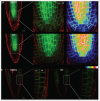The effect of indole-3-carbinol on PIN1 and PIN2 in Arabidopsis roots
- PMID: 26252364
- PMCID: PMC4883967
- DOI: 10.1080/15592324.2015.1062200
The effect of indole-3-carbinol on PIN1 and PIN2 in Arabidopsis roots
Erratum in
- doi: 10.1111/tpj.12824
Abstract
The phytochemical indole-3-carbinol is produced in Cruciferous plants upon tissue rapture and deters herbivores. We recently showed that indole-3-carbinol modulates auxin signaling in root tips. Here we present transcript profiling experiments which further reveal the influence of indole-3-carbinol on auxin signaling in root tips, and also show that I3C affects auxin transporters. Brief treatment with indole-3-carbinol led to a reduction in the amount of PIN1 and to mislocalization of PIN2.
Keywords: Arabidopsis thaliana; auxin; glucosinolate; indole 3 carbinol.
Figures


Similar articles
-
The glucosinolate breakdown product indole-3-carbinol acts as an auxin antagonist in roots of Arabidopsis thaliana.Plant J. 2015 May;82(4):547-55. doi: 10.1111/tpj.12824. Epub 2015 Apr 13. Plant J. 2015. PMID: 25758811
-
Wounding of Arabidopsis leaves induces indole-3-carbinol-dependent autophagy in roots of Arabidopsis thaliana.Plant J. 2017 Sep;91(5):779-787. doi: 10.1111/tpj.13610. Epub 2017 Jul 21. Plant J. 2017. PMID: 28621915
-
Differential Roles of PIN1 and PIN2 in Root Meristem Maintenance Under Low-B Conditions in Arabidopsis thaliana.Plant Cell Physiol. 2015 Jun;56(6):1205-14. doi: 10.1093/pcp/pcv047. Epub 2015 Mar 25. Plant Cell Physiol. 2015. PMID: 25814435
-
Auxin gradients trigger de novo formation of stem cells during somatic embryogenesis.Plant Signal Behav. 2009 Jul;4(7):574-6. doi: 10.4161/psb.4.7.8730. Epub 2009 Jul 15. Plant Signal Behav. 2009. PMID: 19820347 Free PMC article. Review.
-
A Feed-Forward Regulation Sets Cell Fates in Roots.Trends Plant Sci. 2016 May;21(5):373-375. doi: 10.1016/j.tplants.2016.03.002. Epub 2016 Apr 11. Trends Plant Sci. 2016. PMID: 27079491 Review.
Cited by
-
Overexpression of S30 Ribosomal Protein Leads to Transcriptional and Metabolic Changes That Affect Plant Development and Responses to Stress.Biomolecules. 2024 Mar 7;14(3):319. doi: 10.3390/biom14030319. Biomolecules. 2024. PMID: 38540739 Free PMC article.
-
Cardiac glycosides protect wormseed wallflower (Erysimum cheiranthoides) against some, but not all, glucosinolate-adapted herbivores.New Phytol. 2024 Jun;242(6):2719-2733. doi: 10.1111/nph.19534. Epub 2024 Jan 17. New Phytol. 2024. PMID: 38229566 Free PMC article.
-
Genetic variation, environment and demography intersect to shape Arabidopsis defense metabolite variation across Europe.Elife. 2021 May 5;10:e67784. doi: 10.7554/eLife.67784. Elife. 2021. PMID: 33949309 Free PMC article.
-
Dynamic Modeling of Indole Glucosinolate Hydrolysis and Its Impact on Auxin Signaling.Front Plant Sci. 2018 Apr 26;9:550. doi: 10.3389/fpls.2018.00550. eCollection 2018. Front Plant Sci. 2018. PMID: 29755493 Free PMC article.
-
The isothiocyanate sulforaphane induces respiratory burst oxidase homologue D-dependent reactive oxygen species production and regulates expression of stress response genes.Plant Direct. 2022 Sep 6;6(9):e437. doi: 10.1002/pld3.437. eCollection 2022 Sep. Plant Direct. 2022. PMID: 36091879 Free PMC article.
References
-
- Fahey JW, Zalcmann AT, Talalay P. The chemical diversity and distribution of glucosinolates and isothiocyanates among plants. Phytochemistry 2001. 56:5-51; PMID:11198818; http://dx.doi.org/10.1016/S0031-9422(00)00316-2 - DOI - PubMed
-
- Agerbirk N, De Vos M, Kim JH, Jander G Indole glucosinolate breakdown and its biological effects. Phytochem Rev 2009; 8:101-20; http://dx.doi.org/10.1007/s11101-008-9098-0 - DOI
-
- Halkier BA, Gershenzon J. Biology and biochemistry of glucosinolates. Annu Rev Plant Biol 2006; 57:303-33; PMID:16669764; http://dx.doi.org/10.1146/annurev.arplant.57.032905.105228 - DOI - PubMed
-
- Meng Q, Goldberg ID, Rosen EM, Fan S. Inhibitory effects of Indole-3-carbinol on invasion and migration in human breast cancer cells. Breast Cancer Res Treat 2000; 63:147-52; PMID:11097090; http://dx.doi.org/10.1023/A:1006495824158 - DOI - PubMed
-
- Meng Q, Qi M, Chen DZ, Yuan R, Goldberg ID, Rosen EM, Auborn K, Fan S. Suppression of breast cancer invasion and migration by indole-3-carbinol: associated with up-regulation of BRCA1 and E-cadherin/catenin complexes. J Mol Med 2000; 78:155-65; PMID:10868478; http://dx.doi.org/10.1007/s001090000088 - DOI - PubMed
Publication types
MeSH terms
Substances
LinkOut - more resources
Full Text Sources
Other Literature Sources
Molecular Biology Databases
Miscellaneous
